Physical, sexual and emotional violence against women: a general practice-based prevalence study
Danielle Mazza, Lorraine Dennerstein and Vicky Ryan
Abstract - Authors' details - Introduction - Methods - Results - Discussion - Acknowledgement - References - Box 1 - Box 2 - Box 3 - Box 4 - Box 5 - ©MJA1996 -
Abstract
Objective: To determine the prevalence of domestic violence, childhood abuse and sexual assult experienced by women attending general practitioners.Design: A cross-sectional, questionnaire-based prevalence survey.
Setting: 15 general practices in metropolitan Melbourne between November 1993 and February 1994.
Subjects: 3026 women over the age of 18 attending for a consultation.
Results: The response rate was 72%. Over a quarter of women in relationships had been victims of physical or emotional partner abuse in the previous year, one in 10 having experienced severe physical violence. Thirteen percent of women had experienced rape or attempted rape, 10% had been severely beaten during childhood and 28% had experienced childhood sexual abuse involving physical contact. The abuse had been disclosed to the woman's doctor by only 27% of those who had experienced partner or childhood physical abuse (mostly because the doctor had never asked) and 9% of those who had experienced sexual abuse (mostly because the woman did not see it as relevant to the consultation).
Conclusion: There is a high prevalence of physical, sexual and emotional violence against women as well as poor communication about this violence to their general practitioners.
Recommendation: Medical practitioners should be more proactive in questioning women about violence.
(MJA 1996; 164: 14-17)
Introduction
Violence experienced by women results in significant morbidity and, in some cases, mortality. The experience of sexual abuse as a child has been linked to later development of psychological disorders1 and drug abuse and dependence.2,3 Domestic violence has health effects beyond the acute injuries; battered women are more likely to suffer from somatic complaints, anxiety and depression,4 pelvic pain,5 and sexual and gynaecological problems.6 They also use health services more often than women not subjected to domestic violence.7
Because of these associations and because victims of violence are more likely to turn to doctors for help than to any other person,8 they are highly likely to frequent a doctor's surgery. However, doctors are not skilled at recognising them and have been estimated to diagnose only one battered woman in 25.7
This may occur because doctors are unaware of the extent of physical and sexual abuse experienced by their female patients; while the prevalence has been studied in the United States and Europe, Australian data are sparse. The single authoritative study on the prevalence of childhood sexual abuse in Australia was conducted by Goldman and Goldman on a population of university students: 28% of female students and 9% of male students had experienced sexual abuse.9 Two recent studies have looked at the prevalence of domestic violence in Australia, but only in select populations: 23.3% of women attending an emergency department disclosed histories of domestic violence,10 while 8.9% of women in a hospital antenatal clinic stated that they had experienced physical abuse during their pregnancy.11
The aim of our study was to determine the prevalence of domestic violence, childhood abuse and sexual assault experienced by women attending general practitioners and to provide doctors with accurate information on the extent of the problem.
Methods
The study was a questionnaire-based prevalence survey carried out between November 1993 and February 1994. It was approved by the ethics committee of Monash University.
Study population
The study population comprised women over the age of 18 attending their general practitioner for a consultation. Fifteen general practices in metropolitan Melbourne were selected in a two-stage random sampling design described previously.12 The design incorporated practices that were broadly representative of all social classes, from all regions of metropolitan Melbourne. A total sample size of about 3000 women was calculated to be necessary to ensure adequate power, based on results of a pilot study; 220 questionnaires were therefore distributed to each practice.
Questionnaire
Consecutive women attending the practice for a consultation were invited to participate by the practice receptionist.
The questionnaire was introduced by a covering letter, which explained the nature of the study, that it was voluntary and confidential, and that the information disclosed would not be entered in their medical file or given to their doctor. It was acknowledged that some questions might cause distress, and the questionnaire could therefore be completed either in the waiting room or at home and returned in a reply-paid envelope. Respondents were also given contact phone numbers of support services for the different forms of abuse, and informed that their doctor was happy to discuss with them any issues that might arise as a result of the survey. Before the study, doctors were given an information package with details of local support services for abused women.
The self-administered questionnaire asked first for demographic details. Respondents then completed the Conflict Tactics Scale,13 with the modification that they were asked whether the tactic had occurred never, once or more than once in the last year, and with the addition of questions on emotional abuse. In accordance with the Conflict Tactics Scale, physical violence was classified as minor or severe (see Box 1). 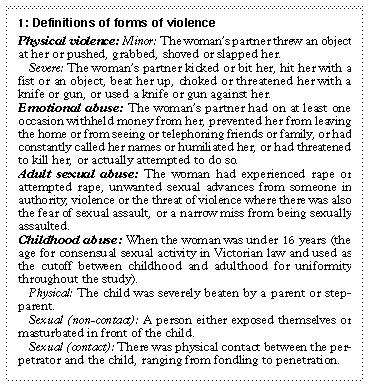
Questions about sexual abuse were derived from the studies of Wyatt14 and Russell,both of 15 which used multiple screening questions to allow time for the respondent to become accustomed to the nature of the questions. Childhood sexual abuse was classified as contact or non-contact (Box 1).
Data were entered into a Microsoft Access database. Frequency tables were generated and prevalences calculated. Because the data came from 15 different general practices and not a simple random sample, confidence intervals (CIs) were adjusted for the effects of clustering.16
Results
Of 3026 questionnaires distributed, 2181 were returned (response rate, 72%). Most questionnaires were completed in the waiting rooms of the practices, with only 18% of those answered returned by post.
Domestic violence
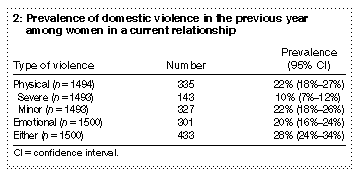
Prevalences for the different categories of domestic violence in the previous year are shown in Box 2. Only those women in a current relationship were asked to complete the section about domestic violence, so that the sample size was smaller than for other parts of the study. A total of 28% of these women had experienced either physical or emotional partner abuse, or both, in the previous year, and (notably) almost one in 10 had been victims of severe physical violence in that year. Among respondents in a current relationship 6% had been kicked, bitten or hit with a fist; 7% had been hit or their partner had tried to hit them with an object; 4% had been beaten up; 4% had been choked; 2% had been threatened with a knife or a gun; and 1% had actually had a knife or gun used against them.
Twenty per cent of those in a current relationship had experienced emotional abuse in the previous year; 4% had their partner threaten or try to kill them; 8% had money withheld; 7% were prevented from leaving their home; 6% were stopped from seeing their friends and family or speaking to them on the phone; and 17% were constantly called names or humiliated.
Adult sexual abuse
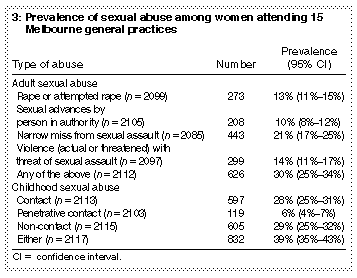
Overall, 30% of women had been victim to some form of sexual abuse since the age of 16. Prevalences of different forms of abuse are shown in Box 3. Just over half of those who reported adult sexual abuse (356/626) had experienced more than one kind.
Childhood abuse
Overall, 10% of women experienced childhood physical abuse (95% CI, 8%-12%); 3% were severely beaten on one occasion and 7% repeatedly.
Almost 40% of women had experienced some form of sexual abuse before the age of 16 (Box 3).
Communication in general practice about violence
The question about whether respondents had ever discussed the issues of domestic violence or childhood physical abuse with their doctors was answered by 1177 women. Among these only 27% had done so, although it was more likely among victims of domestic violence than among non-victims (Box 4). Most women (73%) said that their doctor had never asked them about these things, although this was less likely for victims than for non-victims.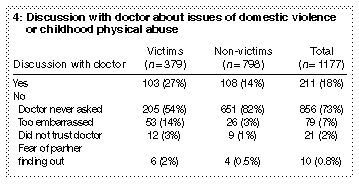
If respondents had experienced either childhood or adult sexual abuse, they were asked if they had ever disclosed this to their doctor; 1009 responded, only 87 (9%) in the affirmative. Reasons given for not disclosing are shown in Box 5.
Discussion
We believe that this study is the first to show the prevalence of physical, sexual and emotional abuse of women in an Australian general practice population. While we recognise that domestic violence and sexual abuse are not exclusively directed by men against women, the study found a high level of violence against women. Over a quarter of women in relationships had been victims of partner abuse in the previous year and one in 10 had experienced severe physical violence; 13% of women had experienced rape or attempted rape; 10% of women had been severely beaten during childhood; and 28% had experienced contact childhood sexual abuse. Despite these levels, few women disclose these events to their doctors.
Our findings are similar to those of a family practice-based study in the United States, which found that 23% of women had been physically assaulted by their partners in the last year.17 In contrast,population-based studies in the United States and Canada estimate that between 10% and 14% of women in relationships experience physical abuse over a one-year period; for 3%-5% of women, the abuse is severe.18-22 Because domestic violence is associated with injury and illness, women sampled in medical environments would be expected to have a higher prevalence than women sampled in community settings. In fact, our findings may underestimate the true prevalence of domestic violence, as women who were separated or divorced were not questioned about their experience of it.
We found a slightly higher prevalence of sexual abuse than that in a recent New Zealand community-based study, which found the prevalence of childhood sexual abuse overall to be 32%, with contact abuse in 25% and penetrative abuse in 4%.23 The differences are again probably due to the different populations sampled.
Potential sources of bias exist. Because of the secret nature of physical and sexual abuse and the stigma attached, there is much controversy over whether self-disclosure by victims can give a true indication of prevalence. A self-administered questionnaire gives no opportunity for clarification of responses by an interviewer. It is also argued that victims will not respond because they fear that disclosure will cause further trauma. These factors would lower apparent prevalence.24 An alternative argument is that victims respond preferentially to surveys when given the opportunity to disclose; non-victims fail to respond as they feel they have no valid information to contribute.24 This would have the reverse effect on apparent prevalence; the two effects could simultaneously counterbalance each other. Another possible source of bias is that the self-administered questionnaire format may have precluded the participation of women from non-English-speaking backgrounds. However, with a sample size of over 3000 and a response rate of 72% (with over 80% of the surveys completed in the general practitioner's surgery), the questionnaire appears to have been well accepted by the
subjects.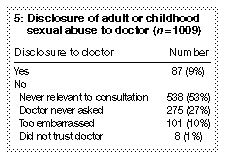
Importantly, about three-quarters of respondents had never been asked by their doctors about domestic violence or childhood physical abuse. This is consistent with results of studies in other countries, which show physician enquiry rates into spouse abuse to be suboptimal.22,25 Contrary to prevailing belief,26 the main reason women did not discuss these issues with their doctor was not because they were afraid, embarrassed or untrusting, but because they were never asked. In addition, 53% of women had not disclosed their experiences of sexual abuse to their doctor because they had never found it relevant to the consultation. Either women are failing to make the connection between sexual abuse and their symptoms or their doctors lack knowledge of the short and long term health effects of sexual abuse.
Doctors are crucially placed to deal with the problem of abuse. Our study suggests that medical practitioners must be more proactive in questioning women about violence. While many may hesitate to identify something they may be unable to directly treat,27 it is important to consider that when a diagnosis of abuse is missed treatment is likely to be inappropriate and potentially harmful.28
Detection is the first step in successful management to deal with both the immediate and long term effects of violence against women. This requires that medical practitioners not only develop the skills to diagnose violence perpetrated against women, but have knowledge of local agencies for referral as well as the legal and criminal options available to the woman.
Acknowledgement
This work was supported by a grant from the Shepherd Foundation in the Department of Community Medicine at Monash University.(©MJA 1996; 164: 14-17)
References
- Mullen PE, Romans-Clarkson SE, Walton VA, Herbison GP. Impact of sexual and physical abuse on women-s mental health. Lancet 1988; 1: 841-845.
- Burnam MA, Stein JA, Golding JM, et al. Sexual assault and mental disorders in a community population. J Consult Clin Psychol 1988; 56: 843-850.
- Winfield I, George LK, Swartz M, Blazer DG. Sexual assault and psychiatric disorders among a community sample of women. Am J Psychiatry 1990; 147: 335-341.
- Jaffe P, Wolfe DA, Wilson S, Zak L. Emotional and physical health problems of battered women. Can J Psychiatry 1986; 31: 625-629.
- Schei B. Psycho-social factors in pelvic pain: a controlled study of women living in physically abusive relationships. Acta Obstet Gynecol Scand 1990; 69: 67-71.
- Schei B, Bakketeig LS. Gynaecological impact of sexual and physical abuse by spouse. A study of a random sample of Norwegian women. Br J Obstet Gynaecol 1989; 96: 1379-1383.
- Stark E, Flitcraft A, Zuckerman D, et al. Wife abuse in the medical setting. An introduction for health personnel. Domestic Violence Monograph Series No. 7. Washington, DC: US Government Printing Office, 1981.
- Dobash RE, Dobash RP. Violence against wives - a case against the patriarchy. New York: Free Press, 1979.
- Goldman R, Goldman J. The prevalence and nature of child sexual abuse in Australia. Aust J Sex Marriage Fam 1988; 9: 94-106.
- Roberts GL, O-Toole BI, Lawrence JM, Raphael B. Domestic violence victims in a hospital emergency department. Med J Aust 1993; 159: 307-310.
- Webster J, Sweett S, Stolz TA. Domestic violence in pregnancy. A prevalence study. Med J Aust 1994; 161: 446-470.
- Mazza D, Dennerstein L, Ryan V. Psychotropic drug use by women: current prevalence and associations. Med J Aust 1995; 163: 86-89.
- Straus MA. Measuring intrafamily conflict and violence: the Conflict Tactics (CT) Scales. J Marriage Fam 1979; 41: 75-88.
- Wyatt GE. The sexual abuse of Afro-American and white-American women in childhood. Child Abuse Negl 1985; 9: 507-519.
- Russell DEH. The incidence and prevalence of intrafamilial and extrafamilial sexual abuse of female children. Child Abuse Negl 1983; 7: 133-146.
- Rao JNK, Scott AJ. A simple method for the analysis of clustered binary data. Biometrics 1992; 48: 577-585.
- Hamberger LK, Saunders DG, Hovey M. Prevalence of domestic violence in community practice and rate of physician inquiry. Fam Med 1992; 24: 283-287.
- Rollins BC, Oheneba-Sakyi Y. Physical violence in Utah households. J Fam Violence 1990; 5: 301-309.
- Schulman MA. A survey of spousal violence against women in Kentucky. Study No. 792701 conducted for the Kentucky Commission on Women. Washington, DC: US Government Printing Office, 1979.
- Smith MD. The incidence and prevalence of woman abuse in Toronto. Violence Vict 1987; 2: 173-187.
- Straus MA, Gelles RJ, Steinmetz SK. Behind closed doors: violence in the American family. New York: Anchor, 1980.
- Straus MA, Gelles RJ. Societal change and change in family violence rates from 1975 to 1985 as revealed by two national surveys. J Marriage Fam 1986: 48; 465-479.
- Anderson J, Martin J, Mullen P, et al. Prevalence of childhood sexual abuse in a community sample of women. J Am Acad Child Adolesc Psychiatry 1993; 32: 911-919.
- Finkelhor D. A sourcebook on child sexual abuse. Beverley Hills: Sage Publications, 1986.
- Martins R, Holzapfel S, Baker P. Wife abuse: are we detecting it? J Wom Health 1992; 1: 77-80.
- Queensland Domestic Violence Task Force. Beyond these walls. Brisbane: Queensland Government, 1988.
- Brown JB, Sas G. Focus groups in family practice research: an example study of family physicians- approach to wife abuse. Fam Pract Res J 1994; 14: 19-28.
- Council on Ethical and Judicial Affairs, American Medical Association. Physicians and domestic violence. Ethical considerations. JAMA 1992; 267: 3190-3193.
- (Received 19 May, accepted 6 Oct 1995)
Authors' details
University of Melbourne, Melbourne, VIC.Danielle Mazza, FRACGP, DRACOG, Lecturer, Key Centre for Women's Health; formerly Assistant Lecturer, Department of Community Medicine, Monash University, Melbourne, VIC.
Lorraine Dennerstein, AO, PhD, FRANZCP, Director, Key Centre for Women's Health.
Vicky Ryan, MSc, Statistician, Statistical Consulting Centre.
(©MJA 1996; 164: 14-17)
Received 21 December 2025, accepted 21 December 2025
- Danielle Mazza
- Lorraine Dennerstein
- Vicky Ryan




